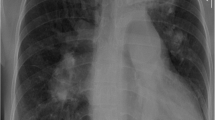Abstract
We present a report on children with severe pulmonary hypertension secondary to congenital heart disease who received 6 months of beraprost therapy. The children had an increase in intracardiac left-to-right shunt and a reduction of the pulmonary-to-systemic vascular resistance ratio, whereas the pulmonary artery pressure was not significantly changed.
Similar content being viewed by others
References
Akiba T, Miyazaki M, Toda N (1986) Vasodilator actions of TRK-100, a new prostaglandin I2 analogue. Br J Pharmacol 89:703–711
Barst RJ, Ivy D, Dingemanse J, et al. (2003) Pharmacokinetics, safety, and efficacy of bosentan in pediatric patients with pulmonary arterial hypertension. Clin Pharmacol Ther 73:372–382
Barst R, McGoon M, McLaughlin V, et al. (2003) Beraprost therapy for pulmonary arterial hypertension. J Am Coll Cardiol 41:2119–2125
Barst RJ, Rubin LJ, Long WA, et al. (1996) A comparison of continuous intravenous epoprostenol (prostacyclin) with conventional therapy for primary pulmonary hypertension. N Engl J Med 334:296–301
Barst RJ, Rubin LJ, McGoon MD, et al. (1994) Survival in primary pulmonary hypertension with long-term continuous intravenous prostacyclin. Ann Intern Med 121:409–415
Bush A, Busst CM, Shinebourne EA (1985) The use of oxygen and prostacyclin as pulmonary vasodilators in congenital heart disease. Int J Cardiol 9:267–274
Christensen DD, McConnell ME, Book WM, Mahle WT (2004) Initial experience with bosentan therapy in patients with the Eisenmenger syndrome. Am J Cadiol 94:261–263
Galie N, Humbert M, Vachiery J, et al. (2002) Effects of beraprost sodium, an oral prostacyclin analogue, in patients with pulmonary arterial hypertension: a randomized, double-blind, placebo controlled trial J Am Coll Cardiol 39:1496–1502
Haneda K, Sato N, Togo T, et al. (1994) Late results after correction of ventricular septal defect with severe pulmonary hypertension. Tohoku J Exp Med 174:41–48
Higenbottam TW, Spiegelhalter D, Scott JP, et al. (1993) Prostacyclin (epoprostenol) and heart–lung transplanation as treatments for severe pulmonary hypertension. Br Heart J 70:366–370
Humbert M, Simonneau G (2004) Sildenafil for pulmonary arterial hypertension; still waiting for evidence. Am J Respir Crit Care Med 169:6–7
Ichida F, Uese K, Hashimoto I, et al. (1997) Acute effect of oral prostacyclin and inhaled nitric oxide on pulmonary hypertension in children. J Cardiol 29:217–224
Ichida F. Uses K, Tsubata S, et al. (1997) Additive effect of beraprost on pulmonary vasodilation by inhaled nitric oxide in children with pulmonary hypertension. Am J Cardiol 80:662–664
Ichida F, Uese K, Tsubata S, et al. (1998) Beneficial effect of an oral analog of prostacyclin on pulmonary hypertension secondary to congenital heart disease. Cardial Youn 8:205–210
Limsuwan A, Platoshyn O, Yu Y, et al. (2001) Inhibition of K+ channel activity in human pulmonary artery smooth muscle cells by serum from patients with pulmonary hypertension secondary to congenital heart disease. Pediatrie Res 50:23–28
McLaughlin VV, Genthner DE, Panella MM, Hess DM, Rich S (1999) Compassionate use of continuous prostacyclin in the management of secondary pulmonary hypertension: a case series. Ann Intern Med 130:740–743
McLaughlin VV, Genthner DE, Panella MM, Rich S (1998) Reduction in pulmonary vascular resistance with long-term epoprostenol (prostacyclin) therapy in primary pulmonary hypertension. N Engl J Med 338:273–277
Nagaya N, Uematsu M, Okano Y, et al. (1999) Effect of orally active prostacyclin analogue on survival of outpatients with primary pulmonary hypertension. J Am Coll Cardiol 34:118–192
Ono F, Nagaya N, Kyotani S, et al. (2003) Hemodynamic and hormonal effects of beraprost sodium, an orally active prostacyclin analogue, in patients with secondary precapillary pulmonary hypertension. Circ J 67:375–378
Rabinovitch M (1995) Pathophysiology of pulmonary hypertension. In: Emmanouilides GC, Riemenschneider TA, Alien HD, Gutgesell HP (eds) Moss and Adams Heart Disease in Infants, Children and Adolescents, 5th ed. Williams & Wilkins, Baltimore, pp 1659–1695
Rosenzweig E, Kerstein D, Barst R (1999) Long-term prostacyclin for pulmonary hypertension with associated congenital heart defects. Circulation 99:1858–1865
Rubin U, Mendoza J, Hood M, et al. (1990) Treatment of primary pulmonary hypertension with continuous intravenous prostacyclin (epoprostenol). Results of a randomized trial. Ann Intern Med 112:485–491
Saji T, Ozawa Y, Ishikita T, Matsuura H, Mastsuo N (1996) Short-term hemodynamic effect of a new oral PGI2 analogue, beraprost, in primary and secondary pulmonary hypertension. Am J Cardiol 78:244–247
Selzer A, Sudrann RB (1958) Reliability of the determination of cardiac output in man by means of the Fick’s principle. Circ Res 6:485–490
Shapiro SM, Qudiz RJ, Cao T, et al. (1997) Primary pulmonary hypertension: improved long-term effects and survival with continuous intravenous epoprostenol infusion. J Am Coll Cardiol 30:343–349
Toda N (1988) Beraprost sodium. Cardio Drug-Rev 6:222–238
Umetsu T, Murata T, Nishio S (1989) Studies on the antiplatelet effect of the stable epoprostenol analogue beraprost sodium and its mechanism of action in rats. Arzneim Forsch 39:68–73
Vizza C, Sciomer S, Morelli S, et al. (2001) Long-term treatment of pulmonary arterial hypertension with beraprost, an oral prostacyclin analogue. Heart 86:661–665
Wagenvoort CA, Wagenvoort N (1979) Pathology of the Eisenmenger syndrome and primary pulmonary hypertension. Adv Cardiol 11:123–130
Acknowledgments
We thank the cardiac catheterization laboratory staff at Ramathibodi Hospital for facilitating the study and the Ramathibodi metabolic ward staff for assisting with patient care. This work was supported by grants from the Cardiac Children Foundation of Thailand.
Author information
Authors and Affiliations
Corresponding author
Rights and permissions
About this article
Cite this article
Limsuwan, A., Pienvichit, P. & Khowsathit, P. Beraprost Therapy in Children with Pulmonary Hypertension Secondary to Congenital Heart Disease. Pediatr Cardiol 26, 787–791 (2005). https://doi.org/10.1007/s00246-005-0925-4
Published:
Issue Date:
DOI: https://doi.org/10.1007/s00246-005-0925-4




